Video review
Hercules has made a name for itself since the very beginning of controllerism releasing “cheap and cheerful” DJ controllers, of the type that prove concept but hardly encourage professionals to take the brand seriously. However, their DJ Console RMX released a few years ago now, was a different beast. Heavy and constructed from metal, it was a pretty indestructible controller – a real workhorse which while still not without its foibles, has stood the test of time and quietly become one of the most popular DJ controllers out there: A real success story.
Now with the DJ Console 4-Mx, Hercules has taken stock of the changes in the marketplace and released what is obviously meant to be a successor to the DJ Console RMX.
It’s in the same casing, it’s the same size, the buttons are the same type, and it still has many of the same features. The crucial differences? Vastly improved jogwheels, and the ability to control four decks out of the box. Let’s take a close look and see if it’s a worthy successor to the RMX…
First impressions/setting up
The first impression is that it just like the RMX. Same size, weight, look and feel. Same clunky controls (Hercules’s buttons, while undeniably heavy duty, are unsubtle). Same general configuration (you can plug extra gear in around the back). It comes with an over-the-shoulder gig bag, too, as its predecessor did, and also like the RMX, has a built-in sound interface.
It has the same curious mix of cheap and expensive that the RMX demonstrated – the crossfader, volume faders and pitch controls are OK but plasticky, as are the rotaries, but we’ve already learned they last the test of time from the RMX; indeed, I tried hard to pull them off and they’re well attached. It’s held together by 30-odd Phillips screws which adds to the confidence you’ll feel in the build quality of the product.
The overall impression is of a workmanlike unit that is going to perform for a long time, and which has been refined from the DJ Console RMX in the areas that matter – the cue, play/pause and stop buttons are considerably better on this unit, for instance – but as mentioned, the most important improvement is in the jogwheels.
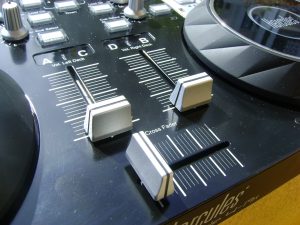
The small, underwhelming wheels from the RMX have been replaced with big jogs with oversized deep rubber grips on the outsides, and see-through acrylic tops, through which “Hercules” logos are visible (that curiously do not spin when the jogwheels do). The jogs can be locked and unlocked by big clamps located underneath the unit, and just like some “real” turntables, they need to be locked for transit and unlocked for use.
Unlike the jogwheels on some other DJ controllers, once unlocked these deliberately have a lot of “give” in them. This makes them actually quite tactile. I like them – they feel ready for action and yet able to take quite a bit of abuse. However, this amount of movement in the jogwheel may not be to you. The “give” is there for a reason – they are touch sensitive, so pushing down on them gives you the same effect as the capacitive top surface on Vestax’s jogs or the “click” on the Traktor S4.
Connections
There are 1/4″ microphone and headphone jacks, and curiously there are two of each – there’s one of each on the front of the unit, and there are duplicates on the top panel, presumably so if your 4-Mx is flightcased and you can’t access the front of it, you can use the sockets on the top instead. A good idea.
Round the back, there are 1/4″ TRS jacks and RCA outputs for the master outs and also a second set of identical outputs. You might expect this to be a booth out with a separate volume control, but actually, it is confusingly configured to give the same output that the headphones receive, ie governed by the PFL.
According to Hercules, this “can be used to connect monitoring speakers which are used by DJs in clubs instead of headphones when they are mixing in an enclosed DJ booth and separated from the audience by a window”. Show me a club like that! It doesn’t make much sense and certainly isn’t a standard monitor out the way it’s set up.
The only real use for this second set of outputs is for using an external mixer, which you can do if you upgrade the software to allow you into this side of the configuration. There’s also a Ground Lift button, a ground pin, the USB socket (for trying to isolate pesky PA humming), and of course the aforementioned line-ins for decks, CDs etc.
Software

The Hercules DJ Console 4-Mx comes with a special 4-Mx version of Virtual DJ 7, meaning you can DJ with four decks right out of the box, unlike some other four-deck controllers which provide you with a two-deck version of their software forcing you to upgrade (ie shell out extra cash) in order to use all four decks. This version also allows you to record, which is something that’s often disabled on light (or “LE”) editions.
There is a special DJ Console 4-Mx skin that you’re stuck within the LE version, which on the plus side is styled to look similar to the DJ Console 4-Mx, but on the minus side is ugly – still, it does the job.
Nonetheless, if you stick with the supplied LE software you don’t get lots of the bells and whistles of the full version of the program. Virtual DJ knows this and gives you the chance to try out the Pro version for 20 days. Turn it on and you’ll see what you’re missing – proper output of video (Virtual DJ is video as well as audio mixing software), the ability to adjust numerous defaults, ID3 tag and latency settings, codecs, and crucially, Midi mappings allowing you to tweak the unit’s controls to work how you want (and indeed add/change keyboard shortcuts if you wish).
As always, the long and short of it is that if you get serious about your DJing, you’ll want the full version of the software so it’ll be time to get your wallet out again and pay the upgrade fee. (For more on Virtual DJ 7, see our Virtual DJ 7 review.)
DJ Console 4-Mx ControlPanel software
The ControlPanel software allows you to adjust various other configurations. The 4-Mx has the ability to control two extra audio inputs, and in the control panel, you can choose what they are (three levels of line input plus phono) and how the unit handles them.

It is possible to route your external inputs through the software in order to give you gain and EQ control over them just the same as if they were one of Virtual DJ’s decks. You can also control the master out volume and balance, the Midi pitch resolution (7 or 14-bit), the sampling rate (16 or 24 bit), the talkover attenuation (ie how much the music cuts when you speak into the mike) and make various other hardware-related tweaks to your set-up from this software. Finally, you can adjust how much the jogs scratch.
In use
The unit is much more compact that, say, the Traktor Kontrol S4, but everything is spaced out enough to make it not too fiddly to use. Of the basic controls, I have to say I found the jogs to be excellent – maybe a little noisy in use but of course with music going you’re never going to notice the physical noise as you manhandle them. They are now up there with the best, allowing you to scratch and nudge with ease.
The EQs are certainly not for the faint-hearted, having absolute kill when turned right down, and a considerable amount of boost in them; there are also kill switches – a nice addition, and one, not enough manufacturers fit their kit in my view. Four keys allow you to navigate up and down folders and through your tunes in your library – you can also put the jogwheels into play here as they allow you to scroll quickly up and down if you keep either the up or down button held while you turn them.
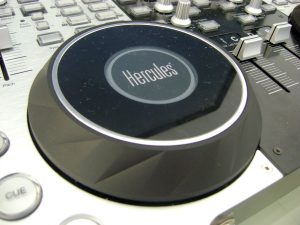
There are source switches for switching in your external line/phono inputs, and deck switch buttons to toggle between the two left and the two right-hand decks. The selected deck is shown directly above the corresponding volume fader for that pair of decks as a lit up A, B, C or D, in blue (A, B) or red (C, D). It would have been nice to have a similar colour scheme on the jogwheels, especially as they also light up when touched; they light up blue regardless of which deck is being controlled.
Having two sets of pitch scale buttons is curious – there is a set on either side of the unit, but adjusting either seems to adjust the pitch scale universally. Basically, they alter how much the pitch fader adjusts the pitch, from 6% through 12, 25, 50 and 100%! 100% actually approximates the switching off of a turntable if you select it and reduce the pitch fader – a good effect.
There are a pair of scrub buttons for each deck, allowing you to quickly move through a track. These are beatsynced which is a nice touch as depending on the musical material, you can skip or double parts of tracks on the fly and your audience shouldn’t notice.
The rest of the basic controls are pretty standard. The pitch bend buttons are a little unnecessary I think as you have the ability to pitch bend with the jogwheels, and there are other controls (such as the “automix” button) that together you may want to reassign to make the mapping suit your workflow – as I said earlier, if you have the Pro version of Virtual DJ you can do just that.
One of the differences between this and the RMX is the number of physical knobs and buttons available to you, and that brings us nicely on to the six buttons and the parameter control knob which each deck gets on this controller. Indeed with shift functionality, you get 12 buttons here.
This is not the most intuitive area of the mapping to use. To start with, the shift buttons’ lights seem to get confused as to whether the button is on or off when you switch between decks, meaning at times they are lit on the console but not on the screen – confusing.
Notwithstanding, with shift pressed, the top two buttons are on-the-fly sample recording and playback, with the knob adjusting sample volume. This is a great feature, although I couldn’t work out how to switch sample positions in the software (there are 10 samples possible in Virtual DJ). Virtual DJ has always had this functionality and it’s good to see it implemented in hardware, albeit in a slightly baffling way (to me, anyway).
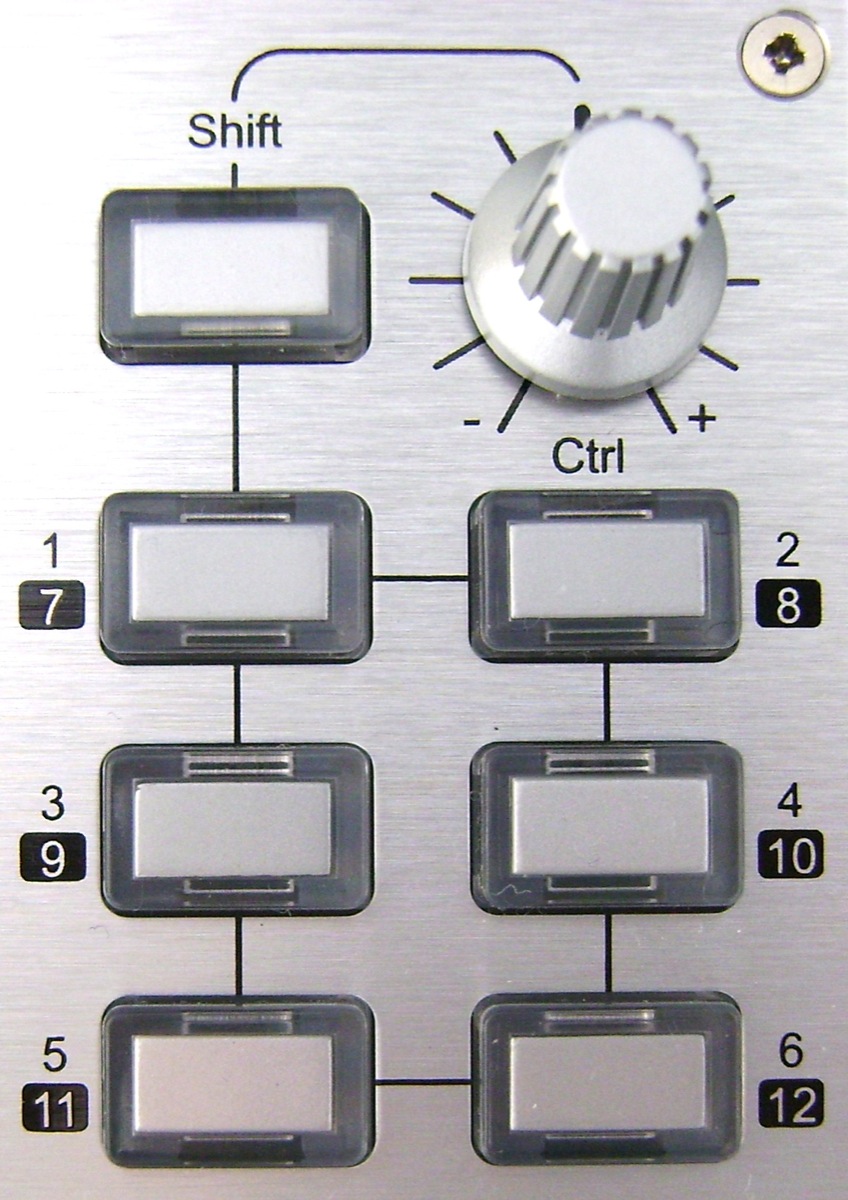
The next four are standard backspin, brake, beatgrid and flanger effects from Virtual DJ, with the knob adjusting an appropriate obvious parameter in most cases. No filters, though. Come on guys, DJs want and love filters! A DJ set-up with filters and nothing else would be infinitely preferable in my view than a raft of lesser effects. Even with the Pro features enabled I couldn’t get access to the filters that I know are in Virtual DJ Pro 7 (although this might have been due to the fact that I couldn’t get any of the standard skins to work in the Pro version for some reason).
Anyway, back to the buttons. Without shift pressed, the top two buttons are a manual loop in and out, with the knob adjusting timed loops from fractions of a beat up to 32 beats. There’s an auto loop icon on the skin that lets your looping be auto quantised to the nearest appropriate beat – but it’s a mouse job to activate it.
Having a knob to control half/double length is actually quite good and lets you come up with some good effects with the right music, but there’s no visual indication on the screen of how long your loop is – again, confusing. The next four buttons without shift pressed are simpler – they’re just hot cues. I had to use the keyboard shortcuts to unset them, though, as could find no way to do it with the hardware.
I only had the unit for a few days and so didn’t have time to get seriously into looking at the mappings, but this is an area where I feel Hercules could improve things. Luckily, Virtual DJ has a great user forum and I am sure the diligent DJ could get his or her sleeves rolled up and map these Midi buttons to do exactly what he or she wanted with the help of the community over there (always, of course, assuming purchase of the full version of Virtual DJ).
One of the remappings I’d immediately do would be to make a button turn keylock on and off – you currently have to click the keylock padlock on the onscreen deck to do this. There are Traktor .tsi files available for the unit too, so the bottom line here is that as long as you’re prepared to get stuck into some Midi mapping, there are lots of buttons you can get to do what you want them to. But if you want a really intuitive, simple set-up out of the box, it’s not quite there yet with the currently supplied mappings.
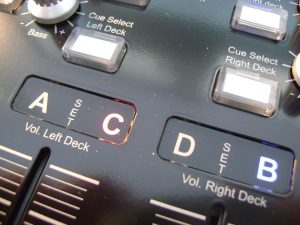
Using four decks with two sets of controls
One obvious question is: With two sets of controls, how does one control four decks satisfactorily? The answer is that the controls get “remembered” by the software, and you turn the control knobs to where they last were in order to “pick up” control again of that parameter.
So if the Bass EQ is turned all the way down on deck A and you switch to deck C and then use that knob there, when you switch back to deck A you have to turn the knob all the way down to “pick up” control of the bass once again. This is good as it avoids sudden jumps on using a control again, and you learn to look at the screen to see where your controls are set for parameters. It’s a good trade-off and in practice, I found it fine to use. However, continuous turning knobs with small lights to show adjustment around their bases are the most expensive way of doing this.
Finally, the sound quality is fine for the market sector, and I didn’t hear any difference from the RMX, although one notable improvement is that the microphone channel seems to be much louder.
Conclusion
At US$475, this controller is around the same price as the American Audio VMS4, a four-deck controller that it can rightfully be compared to. In a direct comparison between the two, the VMS4 is bigger, has four proper channels, and has more inputs, outputs and routing options.
However, the VMS4 could prove a complicated and oversized piece of kit for the digital DJ who doesn’t need such an involved feature set, and there have been rumblings about its build and sound quality; with the Hercules, you’re basically getting a proven piece of kit, the only gamble being on the jogwheels, which nonetheless seem good.
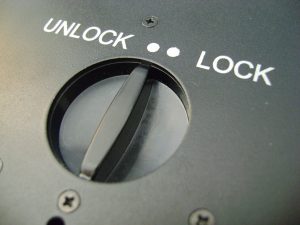
The 4-Mx is more compact, and while basically being a simple DJ controller at heart, the addition of software-routable external inputs, a microphone channel, four decks and better jogs that the VMS4 mean it will appeal to the DJ for whom portability is a good price to pay for less functionality. In short, DJs who like the DJ Console RMX will love this controller. Comparing it to other four-deck controllers that we’ve reviewed is a little unfair as controllers like the Denon DN-MC6000, Traktor Kontrol S4 and Allen & Heath Xone:DX cost a lot more.
While this controller isn’t as refined as the above, it is still excellent value for money. It misses some of the features of truly pro gear (a proper booth output, four “real” channels), but for the enthusiast who wants something good enough to last, and who is prepared to pair it with good DJ software and do some mapping customisation, we recommend it.
Are you an RMX owner? Is this a tempting upgrade for you? Do you think this is good value at this price point or would you rather save and spend more on the Traktor Kontrol S4 or the Denon DN-MC6000? Let us know in the comments.








